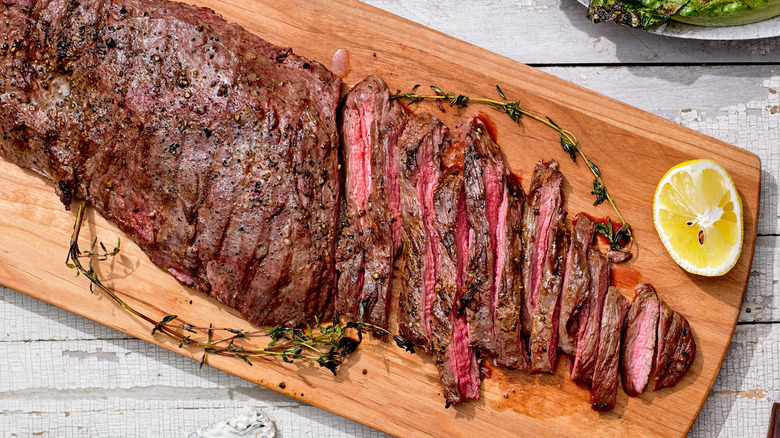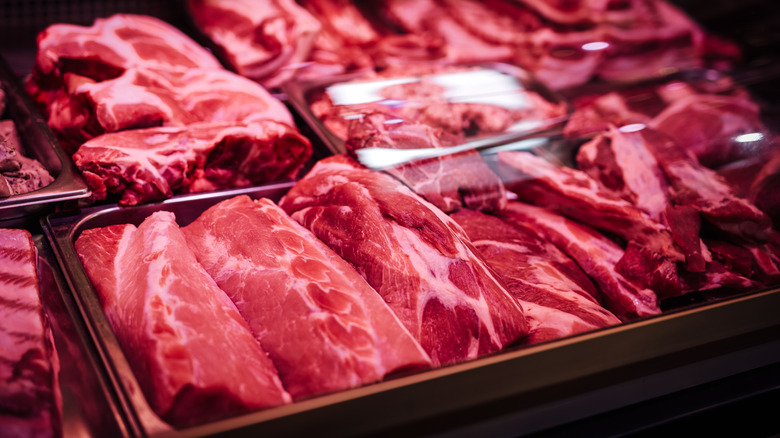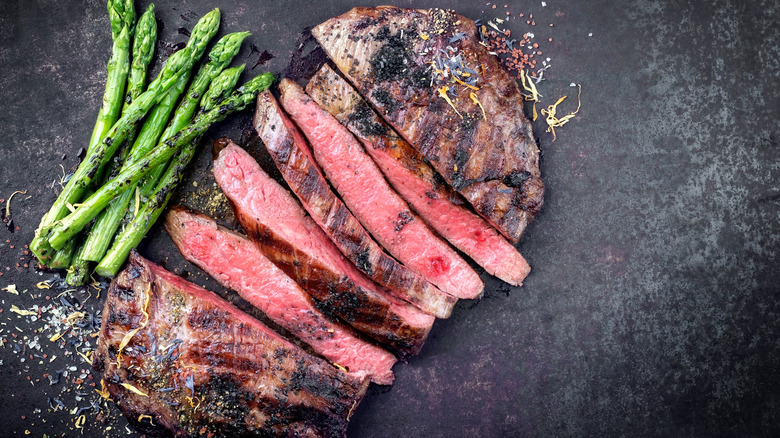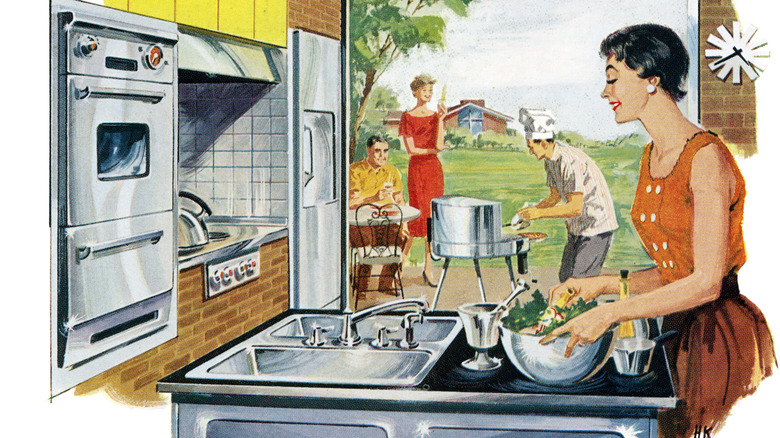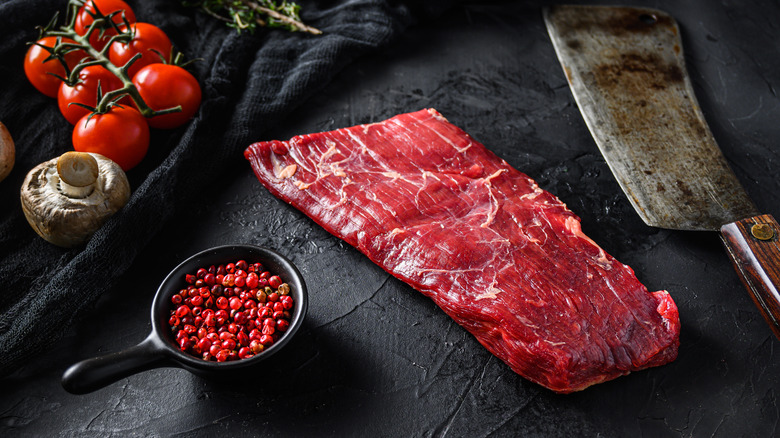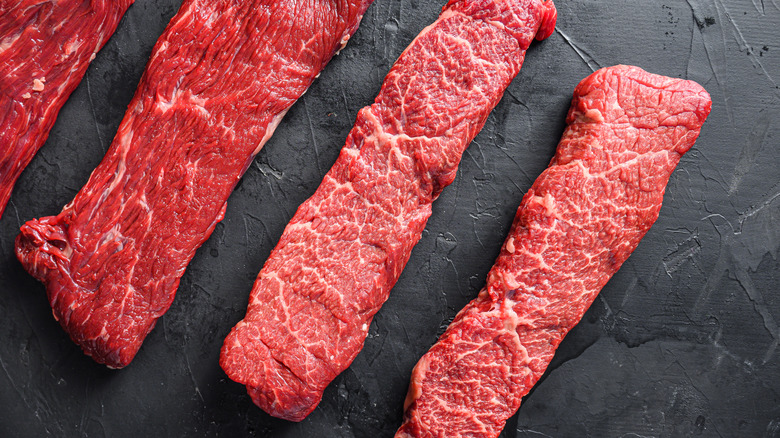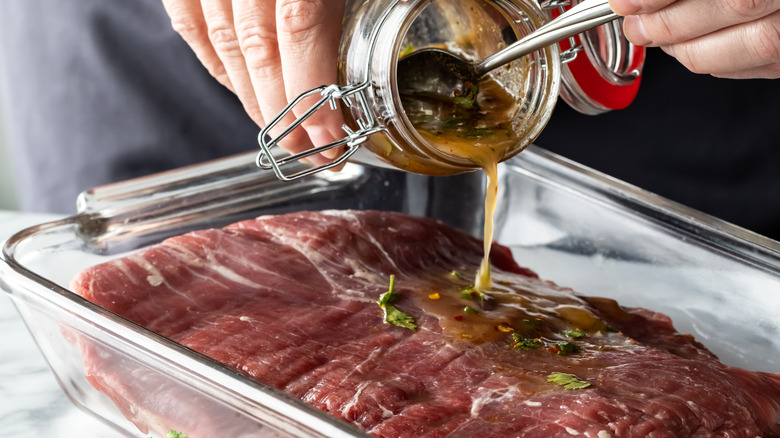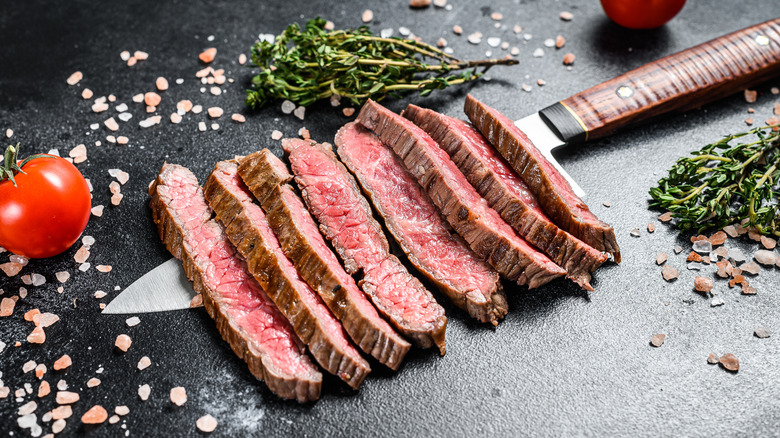The Untold Truth Of London Broil Steak
Retro recipes are back, from vintage cocktails to casseroles to Jell-o salads. It's high time we revitalize yet another old-school classic: London broil. This classic steak recipe goes firmly against the tenets of less-is-more: To make a true London broil, the first step is to marinate the beef for several hours in a rich, tangy marinade that serves double duty as a flavor enhancer and a tenderizer thanks to a copious amount of acid.
The long wait time in the fridge is, thankfully, the longest part of the recipe. Once the marinade has worked its magic, London broil is cooked quickly over (or under) high heat. A few minutes' rest and quick work with a knife to slice it thinly against the grain and this retro classic is ready to serve and enjoy. ut there's more to London broil than meets the eye: From its curious name to its history, here's everything you didn't know you wanted to know about London broil.
London broil is not a cut of meat
Newsflash: While you might find that some packages of meat indicate that "London broil" is what lies within, such a thing cannot be. London broil is, after all, not analogous to a New York strip or a filet mignon in being a specific cut of meat. According to Carlsbad Cravings, London broil is actually a method of preparation that is usually carried out on tougher cuts of steak like flank or top round.
Flank steak is the most traditional cut used in London broil. Hailing from the lower chest or abdomen of the cow, flank steak gets a lot of use during the cow's lifetime and is therefore thick-grained and low in fat — but high in flavor. Top round is another common choice for London broil. Per The Spruce, top round, also known as inside round, is commonly used in roast beef but can also feature in London broil. It's very lean but very flavorful.
London broil is a method of cooking
If London broil isn't a cut, then what is it? As its name suggests, it's a method of cooking (though, perhaps confusingly, not one that hails from London, but rather from Philadelphia, according to TasteAtlas).
The genius of the London broil cooking technique stems from its resourcefulness: Per Carlsbad Cravings, this technique was invented as a means of tenderizing a tough cut of beef by first marinating it in an acidic marinade — usually made with vinegar or lemon juice (or both!) — and then broiling it (or, as The Spruce notes, grilling or pan-frying it, contrary to what its name may have you believe).
Once the meat has rested a bit, the last — and perhaps the most important — step is carried out. The London broil is thinly sliced against the grain, aka the natural fibers running the length of the meat. The resulting thin slices are tender and just bursting with flavor.
London broil first became popular in the '50s
While according to TasteAtlas, the first written record of London broil dated to 1931, it didn't reach its height of popularity until later. Per Bon Appétit, the dish was very popular in the '50s and '60s, and that time period informed the flavors used. At this time in our history, Americans loved higher levels of acidity. Bon Appétit posits that, in addition to just being in fashion, the acidic marinade could also have been a way of masking slightly off flavors in meat. One hopes that's not why people are making London broil these days!
Given the time period during which the recipe first became popular (and regardless of the original motivation), it's no wonder that most London broil recipes contain lemon juice or vinegar — and sometimes both. Recipes may also contain a touch of sweetness in the form of brown sugar or honey, which can balance out the aggressive levels of acidity.
London broil is usually fairly tough
London broil is made with cuts of meat that are fairly tough, and the acid in the marinade serves not only as a flavor enhancer but also as a natural tenderizer, breaking down some of that toughness during the wait in the fridge (via Bon Appétit). As we mentioned above, flank steak, which is the most common cut used for London broil, comes from the abdominal muscle of the cow; the fact that it's a working muscle makes it a little bit tough. According to Science Learning Hub, acidic marinades tenderize meat because they denature proteins, causing the meat to soften. This is useful for cuts like top round (another commonly used cut for London broil) as well as skirt steak, which Simply Recipes says comes from the diaphragm of the cow and is similar to flank, albeit a bit fattier (and therefore even more flavorful).
While the meat that goes into London broil starts out tough, the marinade and slicing make it far easier to swallow. And it's tough (sorry) to imagine a more flavorful final result!
London broil meat is relatively cheap
Whenever a recipe seeks to tenderize tough meat, you can bet that the main ingredient is going to be a cheap one. Indeed, London broil is usually made with cheaper cuts of meat, a characteristic that explains a recent departure from the original cut used to make it.
Flank steak, which is the cut historically linked with London broil, was once fairly cheap (via The City Cook). Once reserved mostly for ground beef or sold cheaply as London broil, flank steak has become more expensive in recent years as the rising price of traditional steak cuts has made consumers hunt for bargains from other parts of the cow. As a result, some cooks now make London broil with other cuts of beef that remain less expensive, such as top round, bottom round, and chuck. According to The Spruce, chuck hails from the shoulder and historically was used almost exclusively for roasts, ground beef, or stew meat.
A marinade is essential for good London broil
London broil just isn't London broil without the marinade. Indeed, this step not only adds flavor; it also improves the texture of the meat being used.
Most London broil marinades share a few characteristics, chief among them some kind of acid. But aside from that main shared factor, there are as many recipes for marinades as there are cooks. The acid may come in the form of balsamic vinegar, red wine vinegar, or lemon juice. Added ingredients may include garlic, Worcestershire sauce, soy sauce, mustard, brown sugar, ginger, honey, and more! Feel free to think outside of the box when it comes to your own London broil recipe, using other citrus such as lime or grapefruit or even infusing this retro recipe with a bit of modern spice in the form of on-trend hot sauces from around the world. Korean gochujang, Thai sriracha, or even an American vinegar-based hot sauce from Cajun country could add even more flavor to your London broil.
London broil can be broiled, grilled, or even pan-fried
The name of London broil might make you think that you need to use the broiler to cook this tasty steak, but in reality, any high-heat cooking method will work. According to TasteAtlas, the original London broil recipe actually called for pan-frying the steak before thinly slicing it. Grilling, either on a barbecue or in a grill pan, would also be great. As a bonus, grilling adds no small amount of delightful charred flavor. And you can, of course, use your trusty broiler to cook this steak until it's tender and juicy with a lovely char on the exterior.
According to The Spruce Eats, you can even slow-cook your London broil to make it even more tender. This method does, of course, demand a bit more time, but if it's a tender and succulent steak you're after, it may be worth the extra wait.
